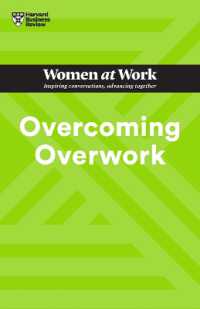基本説明
New in paperback. Hardcover was published in 2008. One of Choice's Outstanding Academic Titles for 2009. Applies transaction cost economics, sociological theory, and legal analysis to explore issues such as the sharing of household output, the control of domestic misconduct, and the ownership of dwelling units.
Full Description
Some people dwell alone, many in family-based households, and an adventuresome few in communes. The Household is the first book to systematically lay bare the internal dynamics of these and other home arrangements. Legal underpinnings, social considerations, and economic constraints all influence how household participants select their homemates and govern their interactions around the hearth. Robert Ellickson applies transaction cost economics, sociological theory, and legal analysis to explore issues such as the sharing of household output, the control of domestic misconduct, and the ownership of dwelling units. Drawing on a broad range of historical and statistical sources, Ellickson contrasts family-based households with the more complex arrangements in medieval English castles, Israeli kibbutzim, and contemporary cohousing communities. He shows that most individuals, when structuring their home relationships, pursue a strategy of consorting with intimates. This, he asserts, facilitates informal coordination and tends ultimately to enhance the quality of domestic interactions.
He challenges utopian critics who seek to enlarge the scale of the household and legal advocates who urge household members to rely more on written contracts and lawsuits. Ellickson argues that these commentators fail to appreciate the great advantages in the home setting of informally associating with a handful of trusted intimates. The Household is a must-read for sociologists, economists, lawyers, and anyone interested in the fundamentals of domestic life.
Contents
Preface xi Chapter 1: how households differ from families 1 Chapter 2: household formation and dissolution in a liberal society 10 Three Distinct Relationships that May Exist within a Household 10 Foundational Liberal Rights that Enable Individuals to Fashion Their Own Households 13 Household Surplus and Its Distribution among Members 22 Chapter 3: The predominant strategy : consorting with intimates 27 Favoring Those with Whom One Will Have Continuing Relations 29 Limiting the Number of Persons in the Relationship 32 Favoring Homogeneity of Tastes and Stakes 32 Chapter 4: a historical overview of household forms 35 Occupants of Households: The Predominance of Small, Kin-Based Clusters 35 Owners of Dwelling Units 41 Residential Landlord-Tenant Relationships 44 Chapter 5: are the household forms that endure necessarily best? 46 Utopian Designs of Unconventional Households 46 Possible Imperfections, from a Liberal Perspective, in the Process of Household Formation 47 Is Liberalism Overly Destructive of Solidarity? 51 The Unpromising History of Experiments with Unconventional Household Forms 53 Chapter 6: choosing which of a household's participants should serve as i ts owners 60 Basic Concepts in the Theory of the Ownership of Enterprise 60 Why Suppliers of a Household's At-Risk Capital Tend to End Up Owning It 64 Chapter 7: The mixed blessings of joining with others 76 Adding Co-Occupants 76 Adding Co-Owners 85 Choosing between Owning and Renting a Home 86 Chapter 8: order without law in an ongoing household 92 The Tendency toward Welfare-Maximizing Substantive and Procedural Rules 94 Sources of Household Rules: In General 101 Rules for Co-Occupants 109 Rules for Co-Owners 120 Rules to Govern the Landlord-Tenant Relationship 123 Chapter 9: The challenge of unpacking the household 128 Appendix A: Data on Intentional Communities 137 Appendix B: Data on Co-housing Communities 145 Notes 147 Works Cited 199 Index 237








